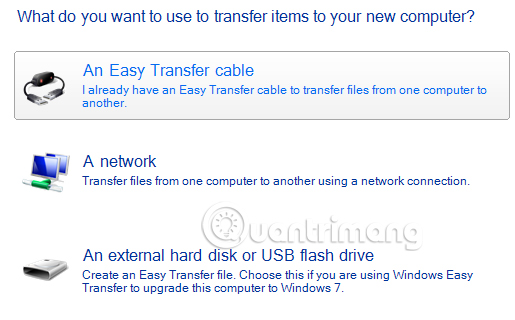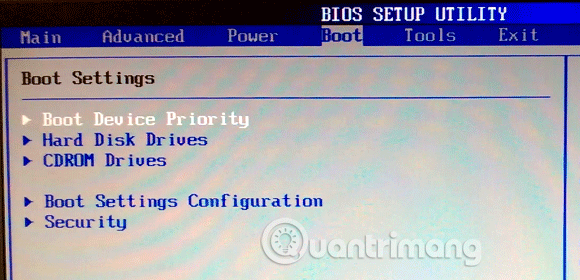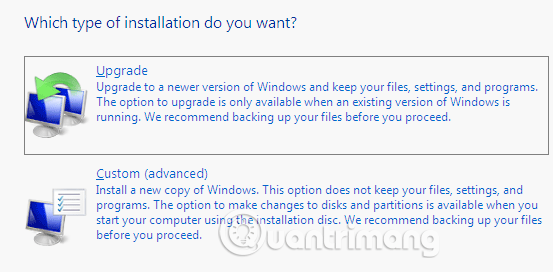Instructions for upgrading Windows XP to Windows 7 or Windows 10
It's hard to believe that Windows XP has a life of more than 15 years. If you still use this operating system and want to upgrade to Windows 7 or Windows 10 to be able to use new features, better protection and software support. This article will show you how to upgrade Windows 7 or Windows 10 and the process is similar. You need to make sure your hardware supports newer operating systems, back up data and then proceed with the upgrade.
How to upgrade Windows XP to Windows 7 or Windows 10
- 1. Check hardware compatibility
- 2. Back up important data
- 3. Install the new operating system
- 4. Restore data and programs
1. Check hardware compatibility
The first thing you need to do is check if your hardware is compatible. This depends on the components in your system.
To check, press the Windows + R key to open the Run dialog box, enter dxdiag and click OK . This will launch the diagnostic tool, providing information about the components you have installed. You will find the necessary information in the System and Display tab.

Compare your current components with Windows 7 or Windows 10 requirements.
Windows 7 system requirements:
- 1GHz processor (32 bit or 64 bit)
- 2GB (32 bit) RAM or 2GB (64 bit)
- Disk space available 16GB (32 bit) or 20GB (64 bit)
- DirectX graphics device with WDDM driver 1.0 or higher.
Windows 10 system requirements:
- 1GHz processor or SoC
- 1GB (32 bit) RAM or 2GB (64 bit)
- Disk space available 16GB (32 bit), 20GB (64 bit)
- DirectX 9 graphics card or newer with WDDM 1.0 driver
Another method you can use if you intend to upgrade to Windows 7 is to download and run the Windows 7 Upgrade Advisor. This program scans hardware, devices and software to find compatibility issues and gives appropriate advice. However, there is no software for Windows 10.
If you have been using the Windows XP system for a long time and have not upgraded any part, you may not be able to run a newer operating system. Do a search for the system component in the manufacturer's website to make sure they provide drivers that support Windows 7 or Windows 10. If not, you should consider buying a new desktop or laptop computer with Windows installed. ten.
2. Back up important data
If you are upgrading from Windows 8 to Windows 10, this upgrade process allows you to keep your programs and personal data. However, you cannot do this when upgrading from Windows XP. You will have to perform a new installation, which means your personal data will be erased. Therefore, before upgrading, you should back up the data.

If upgrading from Windows XP to Windows 7, you can use the Windows Easy Transfer tool to copy files, photos, music, emails, settings and more. When launching the application, you will see a wizard that explains how to do it and asks you to choose the method to use to transfer data. You should use an external hard drive or flash drive to choose what you want to transfer.
Windows 10 does not support the Easy Transfer tool but there are many other easy ways you can use to back up files. You can use physical storage or cloud. The data that is not backed up will be permanently lost so carefully select what you want to save. Most people pay attention to saving user folders containing photos, videos, etc., but you should also keep in mind the specific programs you need to keep.
See also: 6 safe ways to backup and restore data on Windows 7 and Windows 8
3. Install the new operating system
Once your system has met the requirements and backed up everything you need, it's time to install the new operating system. If you have a license key of Windows 7 or Windows 10 without physical means, you need to download the Windows 7 or Windows 10 ISO file. These discs will guide you through the process of creating the installation media yourself, so you A Windows USB disk / USB disk can be booted.
You can refer to some of the following articles:
- Instructions for creating USB boot with Hiren's BootCD quickly
- How to create USB Boot, USB install Windows by Rufus
After creating the boot USB, you can read the article How to check the USB Boot has been created successfully or not? to test and if successful plug it into your system. Now you need the computer to boot from that medium by restarting the computer and accessing the BIOS.

To access the BIOS you need to press a specific key and each operating system uses a different key, usually the Delete or Function key. Access the BIOS and change the boot device order to your installation media at first. You can refer to the article How to set up BIOS to boot from USB / CD / DVD, external hard drive.
Once completed, you will be taken to the Windows 7 or Windows 10 installation process. If notified, make sure to install the copy of Windows, not the upgrade because it will not work.

Set the language, name, settings, etc. then wait for the installation process to complete and the system will automatically restart and enter the new operating system.
4. Restore data and programs
Now that you are using the new operating system, the next step is to restore the program and personal data. If using the Easy Transfer tool, launch it on Windows 7 and follow the instructions. If backing up data in another way, copy them on the new system.
Good luck!
See more:
- Instructions for upgrading Windows 7 to Windows 8 and Windows 8.1
- Instructions on how to upgrade from Windows XP to Windows 8
- How does Windows 7, 8 not automatically upgrade to Windows 10?
You should read it
- How does Windows 7, 8 not automatically upgrade to Windows 10?
- Microsoft details the upgrade process from Windows 7/8/10 to Windows 11
- This is why you should say goodbye to Windows 7 and upgrade your device to Windows 10
- DVD upgrade to Windows 8 costs 70 USD
- How to Upgrade Windows 7 to Windows 8
- Here's how to update your phone to Windows 10 Mobile, whether it's supported or not!
- 2018 already, using Windows 7 should I upgrade to Windows 10?
- Instructions for upgrading from Windows 10 32-bit to 64-bit
May be interested
- How to convert speakers with a shortcut on Windows 10
 usually to switch using audio devices, you need to click the speaker icon in the system tray. however, you can perform this operation with a shortcut key combination.
usually to switch using audio devices, you need to click the speaker icon in the system tray. however, you can perform this operation with a shortcut key combination. - How to fix Touchpad error on Windows 10 does not work
 on windows 10 laptop, recently, quite a lot of users reflect that the touchpad is not working, and they do not know how to fix the error.
on windows 10 laptop, recently, quite a lot of users reflect that the touchpad is not working, and they do not know how to fix the error. - Summary of the common Run CMD commands
 instead of performing manual and direct access operations on windows, we can replace existing cmd commands for faster access.
instead of performing manual and direct access operations on windows, we can replace existing cmd commands for faster access. - How to run a custom task in Windows 10 with Cortana
 that means users can create batch scripts or shells or create their own program to do almost anything.
that means users can create batch scripts or shells or create their own program to do almost anything. - 10 tips to increase productivity on Windows 10
 windows 10 offers a myriad of features that help users organize applications and perform multiple tasks in the most convenient way.
windows 10 offers a myriad of features that help users organize applications and perform multiple tasks in the most convenient way. - 6 ways to access the Boot Options menu in Windows 10
 windows 10 offers many interesting features and advanced boot options, to fix many problems in windows 10, one of them.
windows 10 offers many interesting features and advanced boot options, to fix many problems in windows 10, one of them.






 Still using Windows 7? This is the reason security should upgrade to Windows 10
Still using Windows 7? This is the reason security should upgrade to Windows 10 Instructions on how to upgrade from Windows XP to Windows 8
Instructions on how to upgrade from Windows XP to Windows 8 Notes when upgrading from XP to Windows 7
Notes when upgrading from XP to Windows 7 How does Windows 7, 8 not automatically upgrade to Windows 10?
How does Windows 7, 8 not automatically upgrade to Windows 10? Detailed and simple instructions for transferring Windows from HDD to SSD!
Detailed and simple instructions for transferring Windows from HDD to SSD!